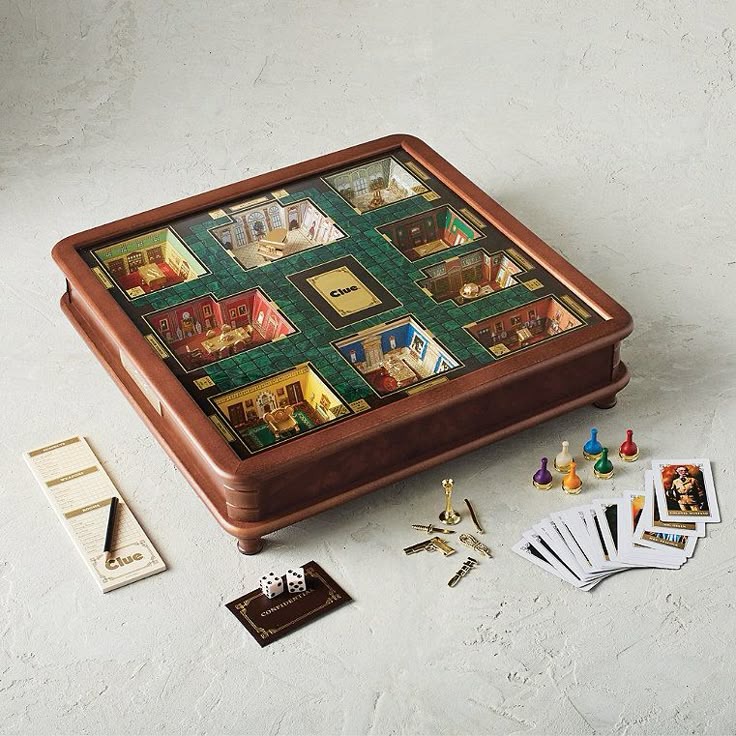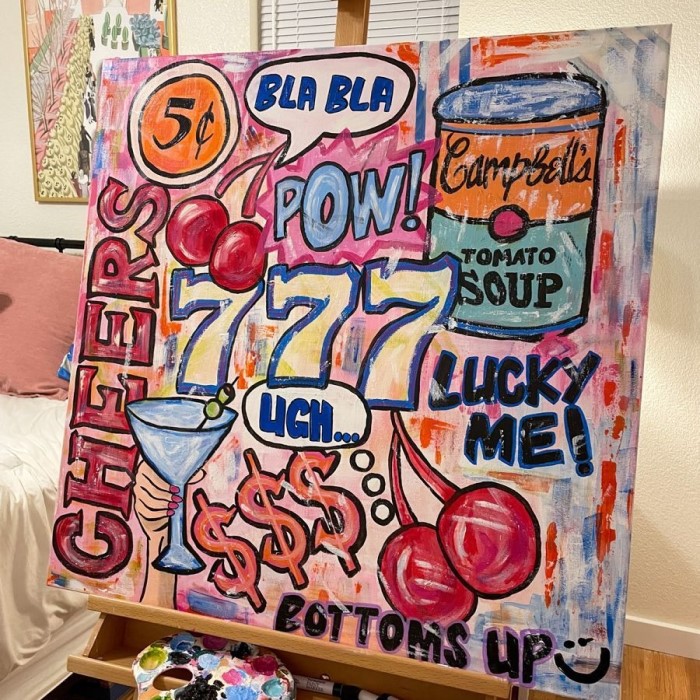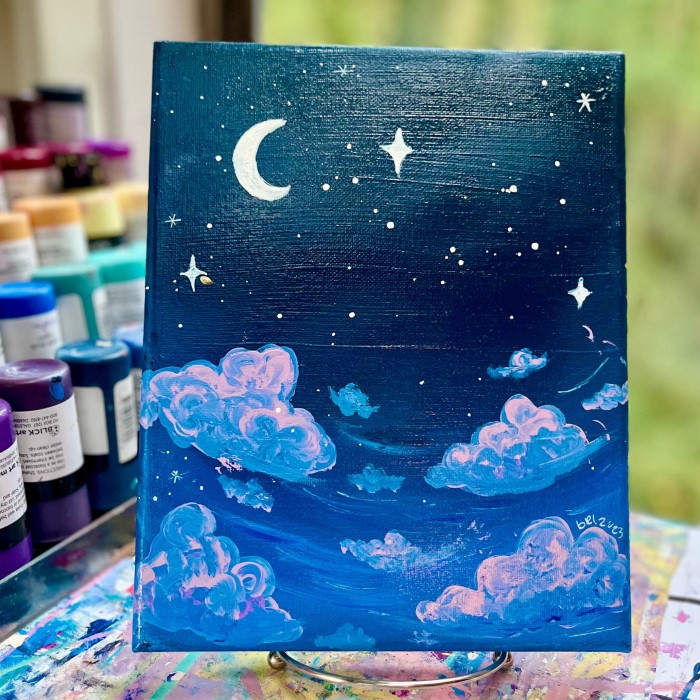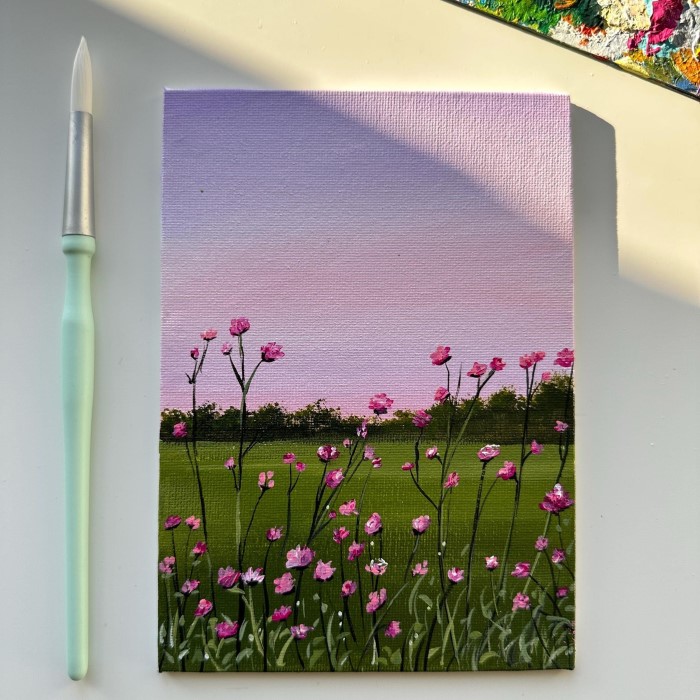Choosing the Right Canvas
Selecting the right canvas is key for acrylic painting on canvas. A good canvas provides the right texture and durability. It sets the foundation for your creative projects.

Types of Canvases for Acrylic Painting
There are different types of canvases for acrylic painting. Stretched canvases are popular because they are pre-mounted and ready to use. Canvas panels are affordable and great for practice pieces. Canvas pads offer portability for quick art sessions. Each type serves different purposes based on your artistic needs.
Some canvases come in cotton or linen materials. Cotton canvases are affordable and versatile for beginners. Linen canvases are durable and ideal for professional-grade artwork. Choose a canvas based on thickness and surface texture for the best results.
Preparing Your Canvas: Priming and Stretching
Priming your canvas ensures better paint adhesion and durability. Most canvases come pre-primed with gesso, but adding extra layers can enhance the surface texture. Apply thin layers of gesso with even strokes for smooth results.
Stretching ensures a taut, even surface for painting. If using an unstretched canvas, secure it onto a wooden frame. Staple the edges tightly while maintaining tension across the surface. A properly stretched canvas prevents sagging and improves the final presentation.
Preparation helps avoid issues like paint cracking or uneven absorption. Always dedicate time to priming and stretching before diving into acrylic painting on canvas.
Essential Acrylic Painting Supplies
Acrylic painting on canvas requires the right tools for successful results. Having the correct supplies ensures smooth painting and enhances your creativity. Below are the essential supplies every acrylic painter should have in their toolkit.

Brushes and Palette Knives
Brushes come in different shapes and sizes for various effects. Round brushes are great for details, while flat brushes are ideal for bold strokes. Fan brushes help create natural textures like grass or trees. An assortment of brushes ensures versatility in your work.
Palette knives are useful for mixing paints and applying thick layers. They are perfect for creating textured effects and bold strokes. Invest in both plastic and metal palette knives, as each has specific uses. Choose durable brushes and knives for long-lasting performance.
Acrylic Paints and Their Variants
High-quality acrylic paints improve the vibrancy and longevity of your artwork. They come in two main types: student-grade and artist-grade. Student-grade paints are affordable and great for beginners. Artist-grade paints have higher pigment concentration, offering richer colors and better coverage.
You can also explore specialized acrylic variants, like heavy-body paints for texture or fluid paints for smooth blending. Some acrylic paints have unique finishes, such as matte, satin, or gloss. Select paints based on your project needs and desired effects.
Additional Tools and Accessories
Supplementary tools help refine your paintings and simplify the process. Here are some must-haves:
- Palette: A flat surface for mixing colors. Use a glass or disposable palette for easy cleanup.
- Easel: Keeps your canvas upright and stable while you paint.
- Rags or Towels: Useful for cleaning brushes and wiping excess paint.
- Spray Bottle: Keeps your acrylic paints moist and prevents them from drying too quickly.
- Container for Water: For cleaning brushes during painting sessions.
Having these tools ensures a well-organized painting experience. Assemble quality supplies to make the most of your acrylic painting on canvas journey.
Techniques for Acrylic Painting
Mastering techniques is essential for success in acrylic painting on canvas. Various methods can elevate your work, helping you create stunning art pieces. Here are foundational approaches to enhance your painting skills.
Layering and Blending Techniques
Layering builds depth and dimension in your artwork. Start with thin base layers, then add details over time. Gradually layer paint while allowing drying between coats to avoid smudging.
Blending creates smooth transitions between colors. Use slightly damp brushes or your fingertips for seamless blends. Always work quickly, as acrylic paint dries fast. Combining layers and blends creates dynamic compositions.
Experiment with glazing for transparency effects. Apply thinned paint layers over dried sections for unique results. Use blending tools such as sponges or brushes to refine transitions.
Using Different Brush Strokes
Brush strokes define your artwork’s style and texture. Use short, controlled strokes for detailing smaller areas or patterns. Long, fluid strokes help in painting backgrounds or large sections.
Experiment with stippling by tapping your brush to create dots and textures. Cross-hatching involves overlapping strokes to create shading and depth. Alternate your brushes for diverse stroke effects.
Dry brush techniques can add texture to painted surfaces. Press dry brush lightly over the canvas for a rough, textured appearance. Understanding these methods will expand your creative range.
Tips for Creating Texture
Texture adds visual interest and tactile feel to your painting. Use palette knives for bold textures or thick paint layers. Try impasto techniques to create raised, dramatic paint surfaces.
Objects like sponges or bristles can form unique surface effects. Experiment with acrylic gels and mediums for additional texture. They blend well with paint, altering its thickness and finish.
Layer textures strategically to avoid cluttered composition. Combine tools and techniques to achieve balanced, dynamic results. Textured paintings are both visually striking and engaging to touch.
Color Mixing and Theory
Understanding color mixing and theory is essential for vibrant acrylic painting on canvas. Colors create emotion, balance, and visual impact in your artwork. Learning these concepts helps improve your creativity and final results.
Choosing a Color Palette
A well-thought-out color palette sets the mood of your painting. Start by selecting a few primary colors such as red, blue, and yellow. Mix them to create secondary and tertiary colors. Limited palettes often produce harmonious results.
Consider the theme of your artwork when choosing colors. Warm tones like orange and red evoke energy and passion. Cool tones like blue and green give a calm and serene feeling. Neutral shades like white or black help balance vibrant colors.
Using complementary colors creates contrast. For instance, pair blue with orange or purple with yellow. Analogous colors, such as greens and blues, work well for subtle transitions. Experiment with palettes to discover combinations that suit your style.
Mastering Color Blending
Blending colors allows smooth transitions and richer effects. Begin by mixing small amounts of paint on your palette. Add white paint to lighten a shade or black to darken it. Use gradual changes for seamless blends.
Work quickly, as acrylic paint dries fast. Use damp brushes for smoother blending. Layer colors thinly for better precision and control. Gradual layering enhances the depth and vibrancy of your work.
Apply glaze techniques to achieve transparency. Mix paint with glazing medium and layer it over dried areas. This method adds subtle overlays and softens the artwork. Practice blending regularly to improve your skills over time.
Creating Depth with Color
Depth gives your painting a three-dimensional effect. Use light and dark shades to create contrast. Highlight objects with bright colors and shadows with darker tones. This creates a sense of distance and spatial depth.
Use color gradients to show perspective. Open spaces often fade into lighter or cooler colors. For example, a landscape can transition from vivid greens to soft blues in the background.
Play with saturation to emphasize focal points. Highly saturated colors attract attention, while muted ones balance the composition. Understanding depth techniques enhances visual appeal and realism in your acrylic painting projects.
Common Mistakes and How to Avoid Them
Acrylic painting on canvas is a rewarding art form. However, it’s easy to make mistakes that impact your work. Avoiding common pitfalls can improve your skills and help you achieve better results. Below are key issues and tips to resolve them.
Overusing Paint or Water
Too much paint can overwhelm the canvas and create uneven surfaces. Use small amounts instead. Thin layers work best for building color and texture. Overusing water dilutes acrylic paint and weakens its vibrancy. Mix water sparingly to maintain strong pigments. Test your mixtures on scrap materials before applying them to your canvas. This helps you achieve the right paint consistency.
Handling Drying Time Challenges
Acrylic paint dries quickly, which can cause stress for beginners. Focus on blending fast during application. Use a spray bottle to keep paints moist while you work. If paint dries prematurely, layer over it instead of forcing it to blend. Plan your painting steps in advance to avoid rushed blending. Work section by section to manage drying issues more effectively.
Fixing Errors on Canvas
Mistakes like uneven strokes or smudges are common. Let the paint dry completely before fixing them. Correct errors by painting over them with fresh layers or gesso. For smaller mistakes, use palette knives or fine brushes for touch-ups. Wet rags or sponges can clean fresh errors quickly. Patience and careful corrections enhance your artwork without visible flaws.
Cleaning and Maintenance Tips
Proper cleaning and maintenance extend the life of your art supplies. Protect your tools, paints, and artworks by following these simple yet effective tips.
Cleaning Brushes and Tools Effectively
Clean your brushes immediately after painting to prevent paint from drying. Rinse them thoroughly in water for water-based acrylics. Use gentle soap to remove stubborn paint residues. Avoid soaking brushes to protect their shape and bristles.
For palette knives and other tools, wipe excess paint with a cloth or paper towel. Clean them with water or a cleaner suitable for acrylics. Dry them completely to avoid rust or residue buildup.
Regular cleaning keeps tools in good condition and ensures better performance during painting sessions.
Storing Your Paints Properly
Store acrylic paints in a cool, dry place to maintain their quality. Keep them away from direct sunlight or extreme temperatures. Secure the lids tightly to prevent drying. Always store paints upright to avoid leakage.
For larger paint collections, use clear containers or organizers for easy access. Label your paints if necessary to identify shades quickly. Proper storage ensures your paints remain usable for longer periods.
Preserving Finished Paintings
Protect your completed acrylic paintings with a varnish layer. Use a brush-on or spray varnish for even coverage. Wait until the painting is completely dry before applying varnish.
Store finished paintings in a dust-free, humidity-controlled environment. Use protective covers or frames to avoid damage. For canvases, consider using spacers to prevent direct contact with the frame’s glass.
Preservation safeguards your artwork, ensuring it stays vibrant and intact for years to come.
Creative Ideas for Acrylic Painting Projects
Acrylic painting on canvas offers endless possibilities for creative expression. Here are some popular ideas to inspire your next project.
Abstract and Geometric Patterns
Abstract art allows freedom with shapes, colors, and techniques. Use bold strokes and textures for dynamic pieces. Experiment with geometric patterns like circles, squares, or triangles for structured designs. Blend contrasting or complementary colors to create engaging visuals. Layer paints to add depth and dimension to your patterns. Acrylic mediums can enhance textures and create striking effects in abstract works.
Realistic Portraits and Landscapes
Painting realistic subjects challenges and improves your skills. Create detailed portraits by layering colors for lifelike skin tones. Focus on facial expressions, shadows, and highlights for realism. For landscapes, pay attention to perspective and light. Use a blend of greens, blues, and browns for natural sceneries. Include elements like trees, water, and skies for a complete composition. Ensure smooth blending of colors for seamless realistic effects.
Exploring Mixed Media Art
Mixed media combines acrylic paint with other materials like paper, fabric, or photography. Use acrylics to form a base layer, then layer with additional elements. Incorporate collage techniques using magazines or textured papers. Explore gels, pastes, and other mediums for unique effects. Mixed media art allows experimentation and innovation, making each piece unique. Let your creativity flow freely to achieve unexpected and exciting outcomes.
Conclusion
In conclusion, mastering acrylic painting on canvas is an enjoyable journey filled with creativity and exploration. By gathering the right supplies, practicing essential techniques, and embracing your artistic expression, you can develop your skills to create stunning works of art. Remember, every artist was once a beginner, and the most important thing is to enjoy the process and experiment fearlessly. With the tips and tricks provided in this article, you are now equipped to embark on your adventure into the world of acrylic painting!


